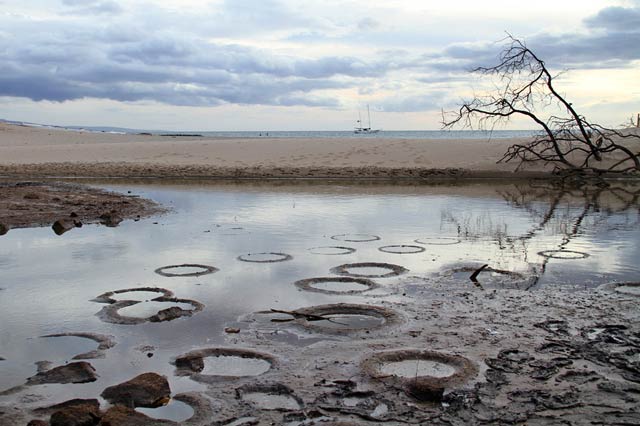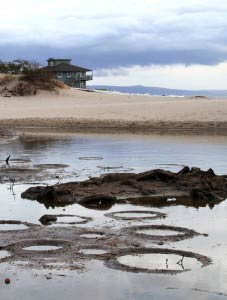
While driving along North Kihei Road, something caught my eye in the standing water behind the big dune near the Whale Sanctuary Building. I knew it couldn’t be, but they looked just like the coral micro-atolls in the Olowalu area. But these were in fresh/brackish water where corals would not be living, so what could they be? I had to know. I went back with my camera, photographing the rings and trying to see any indication of what might have made them. But the water was murky, and other than some tiny creatures zipping around and touching the surface of the water from beneath, I saw nothing.
A Google search of “mud rings” yielded only the (apparently) well-known item used in electrical installations. So I started to ask around instead. As usual, Cory Pittman was able to point me in the right direction. They were fish nests! Made by an introduced group of fish called tilapia.

The Mozambique tilapia (Oreochromis mossambicus), one of the tilapia introduced to Hawaii in the 1950s.
Tilapia is the generic term for a group of African cichlids, a huge family of freshwater fish found worldwide. According to Hawaii’s Native and Exotic Freshwater Animals by Mike Yamamoto and Annette Tagawa at least 10 species of tilapia have been introduced to Hawaii since the 1950s as a source of food, to control vegetation overgrowth, and to provide recreational opportunities. Because they are tolerant of brackish water, low oxygen, high temperature, and high ammonia concentrations, they can survive in wetland areas with limited circulation, in drainage ditches, and in areas of standing water close to the coastline.
 Like their damselfish relatives, tilapia don’t just release their eggs and sperm into the water, but lay their eggs on the bottom and fiercely protect them during development. It is the male’s job to make a nest and attract females to lay their eggs within. As described in an online aquaculture article, the male “excavates a nest in the pond bottom.” This is a pretty weak description for a skill that results in such precisely circular nests. I am certain that even with two hands and a whole day I would not be able to construct such a perfect ring.
Like their damselfish relatives, tilapia don’t just release their eggs and sperm into the water, but lay their eggs on the bottom and fiercely protect them during development. It is the male’s job to make a nest and attract females to lay their eggs within. As described in an online aquaculture article, the male “excavates a nest in the pond bottom.” This is a pretty weak description for a skill that results in such precisely circular nests. I am certain that even with two hands and a whole day I would not be able to construct such a perfect ring.
So how does he do it? While I wasn’t able to find a decent video online showing male tilapia nest building, I did find one of a male sunfish (a close relative) doing so in an aquarium. View the nest building technique. It turns out that the male uses his tail fin to make this work of natural art.
These beautiful nests go unnoticed because they are normally below the surface. Because of tidal fluctuation and low water flow, the rims of the nests were exposed on this day.

Comments 2
That is SO funny…I saw these a few weeks ago, thought the same thing since you & Cory had shown me the atolls in Olowalu, but then thought, “No way…it must be something manmade – coral’s not in there!”
Thanks for figuring it out and sharing!!! Is it a problem that there’s a “land plug” that doesn’t really regularly provide an ocean outlet there?
Author
See? You are a natural scientist! I don’t know if it’s a “problem” for the fish. During storms it is a problem for humans because flooding occurs when water can’t flow to the ocean. I don’t think it is necessarily a problem for the fish. There are native fish in the Kalama Park creek, and that doesn’t usually flow to the ocean, so it’s probably OK as long as the fish have water they can retreat back to.